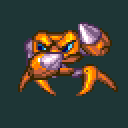
8DashP
-
Posts
60 -
Joined
-
Last visited
-
Days Won
3
Reputation Activity
-
 8DashP got a reaction from lucid in Spriter 2: Alchemist Kickstarter is live!
8DashP got a reaction from lucid in Spriter 2: Alchemist Kickstarter is live!
Thanks Mike.
It’s been a long road since I first purchased in 2013. You may or may not remember I built a plugin for Shiva3D way back when, but then they screwed over their developers and basically died, and it left such a bad taste, that I quit the game development industry. Life has moved on, and I’m now starting again in Unity and maybe Godot. I can see an opportunity to develop a Godot plugin, but I’d definitely need to get a better handle on what features and functionality are coming, to decide whether to commit, so any updates would be greatly appreciated.
Hope you get the support you need and can push forward to plan.
Russell.
-
 8DashP got a reaction from Mike at BrashMonkey in Spriter 2: Alchemist Kickstarter is live!
8DashP got a reaction from Mike at BrashMonkey in Spriter 2: Alchemist Kickstarter is live!
Nice to see a big list of features. It sounds like a very ambitious project, and probably something needed to differential Spriter from the competition in the current market. I must confess however, it is all quite confusing as to what the end result will be.
The ideas behind the control widgets and procedurally generated characters in particular are hard to envisage how this would be implemented in a game development package. It almost seems like you want Spriter to be the game engine. Are the widgets going to be exportable components to be imported into the end user game engine, or are they used within spriter simply to render out generated images to, for example, sprite sheets, or animation states? This is just an example of what is unclear from the Kickstarter page to me, which makes it hard to decide whether to invest or not, and even whether this is all Alchemist functionality, or a mix of Spriter 2 and Alchemist. My assumption is that everything shown is Alchemist specific and won’t be available in Spriter 2 base.
It would be good to see some more in-depth examples of specific functionality. Not sure if development is far enough along to do this though.
Russell.
-
 8DashP got a reaction from Arrgincey in scml documentation (deprecated - use reference implementations instead)
8DashP got a reaction from Arrgincey in scml documentation (deprecated - use reference implementations instead)
Apart from the bugs in the reference code, I think it's still pretty much valid and should just need adding to with new features.
My Shiva implementation is in C++, but using Shiva API's for image, object and screen manipulation as Shiva is a 3D environment, not 2D. I've had to modify some of the reference data structures to make sense in my environment, mainly around the timeline, bone and object keys, as turning 2D images into 3D objects but still treating like 2D objects requires some lateral thinking, and coding.
I started with the generic C++ code! but have virtually rewritten it all as my deviations for my environment were turning it into spaghetti code, and I wanted to stay closer to the reference implementation.
So overall, the basic algorithms and data structure are sound. It's getting it into your runtime environment that takes all the work.
-
 8DashP got a reaction from DarrenOl in scml documentation (deprecated - use reference implementations instead)
8DashP got a reaction from DarrenOl in scml documentation (deprecated - use reference implementations instead)
Apart from the bugs in the reference code, I think it's still pretty much valid and should just need adding to with new features.
My Shiva implementation is in C++, but using Shiva API's for image, object and screen manipulation as Shiva is a 3D environment, not 2D. I've had to modify some of the reference data structures to make sense in my environment, mainly around the timeline, bone and object keys, as turning 2D images into 3D objects but still treating like 2D objects requires some lateral thinking, and coding.
I started with the generic C++ code! but have virtually rewritten it all as my deviations for my environment were turning it into spaghetti code, and I wanted to stay closer to the reference implementation.
So overall, the basic algorithms and data structure are sound. It's getting it into your runtime environment that takes all the work.
-
 8DashP got a reaction from IzbranniY in scml documentation (deprecated - use reference implementations instead)
8DashP got a reaction from IzbranniY in scml documentation (deprecated - use reference implementations instead)
Apart from the bugs in the reference code, I think it's still pretty much valid and should just need adding to with new features.
My Shiva implementation is in C++, but using Shiva API's for image, object and screen manipulation as Shiva is a 3D environment, not 2D. I've had to modify some of the reference data structures to make sense in my environment, mainly around the timeline, bone and object keys, as turning 2D images into 3D objects but still treating like 2D objects requires some lateral thinking, and coding.
I started with the generic C++ code! but have virtually rewritten it all as my deviations for my environment were turning it into spaghetti code, and I wanted to stay closer to the reference implementation.
So overall, the basic algorithms and data structure are sound. It's getting it into your runtime environment that takes all the work.

